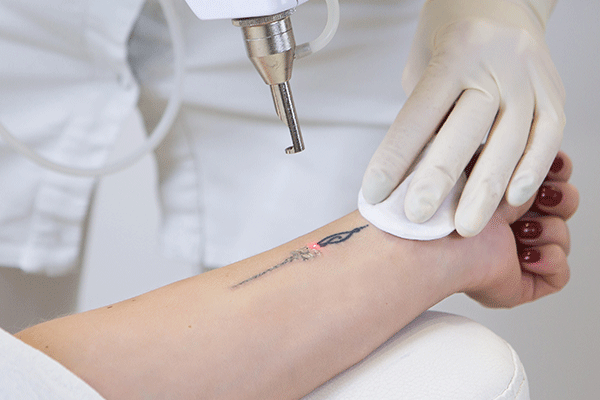Many people acquire tattoos as a means of self-expression, with some making this decision on a whim. As such, it’s common for a tattoo to become less appealing over time. This shift typically mirrors changes in an individual’s life, personal development, or evolving tastes. Consequently, those who find significant reasons for change may choose to undergo tattoo removal.
Only in the 1980s did tattoo removal become much more effective and safer through laser technology. Laser tattoo removal has emerged as a revolutionary method, offering a precise and effective way to erase the ink embedded in the skin.
If you’ve been searching ‘laser tattoo removal near me’ but are mainly curious about how laser removal works, you’ve stumbled upon the right page. This blog discusses everything you need to know about the process.
Mechanism Of Laser Tattoo Removal
The core of laser tattoo removal lies in the intricate processes of absorption, selective targeting, and the subsequent breakdown of ink particles. Lasers deliver precise energy to shatter tattoo pigments without causing significant damage to surrounding skin tissue. Through photothermal and photochemical reactions, laser technology is a highly effective removal technique.
Types Of Laser Tattoo Removers
Various types of lasers have been developed to address the diverse spectrum of pigments used in tattoos. Understanding the basic mechanisms of laser technology is key to appreciating the intricate science behind successful tattoo removal.
- Q-Switched Lasers
The pioneer in modern tattoo removal, Q-switched lasers emit high-intensity pulses of light in extremely short durations (nanoseconds). Their short pulses create a photomechanical effect, breaking down ink particles into smaller fragments without causing extensive damage to surrounding tissue.
- Ruby Lasers
Ruby lasers were among the first lasers used for tattoo removal. They operate at a wavelength absorbed well by blue and green pigments. While effective for certain colours, their use has diminished with the development of more versatile laser systems.
- Alexandrite Lasers
Operating at a longer wavelength than ruby lasers, alexandrite lasers are effective for removing green and dark black pigments. Their versatility makes them suitable for a broader range of tattoo colours.
- Nd:YAG Lasers
Neodymium-doped yttrium aluminium garnet (Nd:YAG) lasers operate at longer wavelengths, making them suitable for removing darker pigments. They’re especially effective for black and blue inks, and their longer wavelength makes them safer for individuals with darker skin tones.
- Picosecond Lasers
An advancement over Q-switched lasers, picosecond lasers emit pulses in picoseconds, resulting in even faster and more efficient ink particle fragmentation. Picosecond lasers are particularly effective for stubborn tattoos and can target a broader range of colours.
- Fractional Lasers
Fractional lasers deliver laser energy in a fractionated pattern, creating micro-injuries to the skin. While not as commonly used for tattoo removal, fractional lasers can aid in the removal process and promote skin healing.
 The Treatment Process
The Treatment Process
Laser tattoo removal is a meticulously orchestrated process that involves harnessing the power of light to dismantle the ink particles embedded in the skin. So what are the main steps that constitute this innovative process?
- Consultation And Skin Assessment
The journey begins with a thorough consultation where an expert assesses the individual’s tattoo and skin type. Remember, factors such as tattoo size, colours, depth, and the client’s skin tone play a crucial role in determining the laser parameters.
- Protective Measures
Before the laser treatment begins, the practitioner may apply a topical anesthetic to minimise discomfort. Protective eyewear is provided to shield the eyes from the intense laser light.
- Laser Calibration
The practitioner selects the appropriate laser type and adjusts the settings based on the tattoo’s characteristics. Different wavelengths target specific colours, ensuring precision in breaking down diverse pigments.
- Laser Pulses
The laser emits high-energy pulses of light that penetrate the skin and are absorbed by the tattoo pigments. Q-switched lasers and their advanced counterparts generate pulses in nanoseconds or picoseconds, creating a photomechanical effect.
- Photoacoustic Effect
The rapid energy delivered by the laser causes a photoacoustic effect, shattering the ink particles into smaller fragments. This fragmentation is pivotal, as it enables the body’s natural processes to gradually eliminate the ink.
- Lymphatic System Clearance
The fragmented ink particles are carried away by the body’s lymphatic system over time. Multiple sessions are typically required, allowing the lymphatic system to progressively clear the ink remnants.
- Healing and Recovery
Following each session, the treated area may experience redness, swelling, and a sensation similar to a sunburn. Post-treatment care, including keeping the area clean and staying protected from the sun, is essential for optimal healing.
- Subsequent Sessions
Laser tattoo removal is a gradual process, often requiring multiple sessions spaced several weeks apart. The number of sessions primarily depends on tattoo size, ink colours, and skin response.
- Assessment And Adjustments
Throughout the process, the practitioner assesses the tattoo’s fading progress and may adjust laser settings accordingly. The personalised approach ensures the best possible outcome while minimising the risk of side effects.
Conclusion
The science of laser tattoo removal involves many biological and technological factors designed to reduce pain during the process. So if you plan to get rid of these marks on your skin, you can do it today without worrying about a seemingly unbearable experience. The treatment process involves consultation with an expert, laser calibration, removal, and healing.




